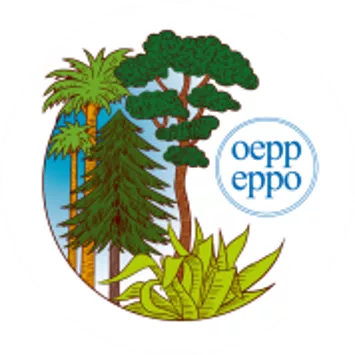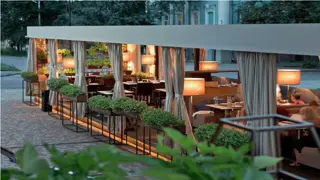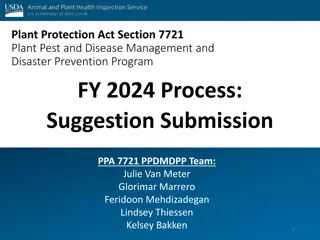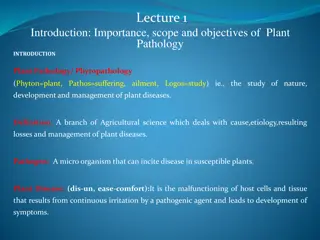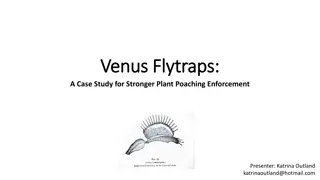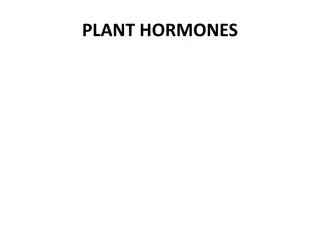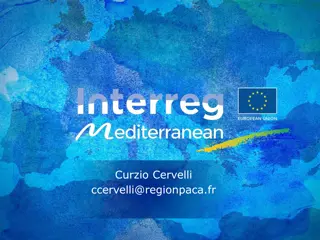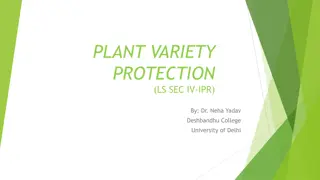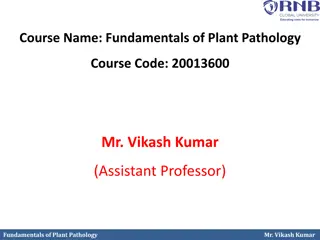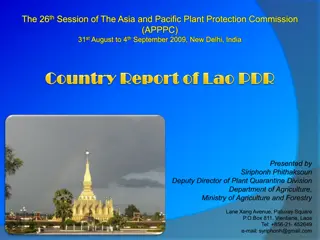European and Mediterranean Plant Protection Organization Overview
The European and Mediterranean Plant Protection Organization (EPPO) was established in 1951 and has grown to encompass 51 member countries across Europe, North Africa, the Mediterranean, and Central Asia. EPPO focuses on plant quarantine and protection products, with a dedicated team managing various programs. The organization collaborates on projects such as Euphresco and works on harmonizing data requirements for plant protection. Phytosanitary regulations, global affairs, forestry, potatoes, and invasive plants are among the key areas of work for EPPO.
Download Presentation

Please find below an Image/Link to download the presentation.
The content on the website is provided AS IS for your information and personal use only. It may not be sold, licensed, or shared on other websites without obtaining consent from the author. Download presentation by click this link. If you encounter any issues during the download, it is possible that the publisher has removed the file from their server.
E N D
Presentation Transcript
The European and Mediterranean Plant Protection Organization Presentation to 28th Technical Consultation among RPPOs 2016-11-14/18 Rabat
Specificities of EPPO founded 1951 by 15 countries now 51 member countries Europe (almost all countries), N Africa, Mediterranean, Central Asia 15 panels on plant quarantine, 5 on plant protection products c. 15 staff working on core programme 5 Expert Working Groups per year on PRA Core work funded by member country contributions (c.65%) Plus projects with other funders (c.35%) - 5 main ones currently Euphresco (35 members in 2016) EU Minor Uses Co-ordination Facility (EU, DE, FR, NL) RNQPs for the EU (EU - DG Sante) LIFE Invasive Plants (EU - DG Environment) DROPSA (EU - DG Research)
EPPOs Organisation National Plant Protection Organisations EPPO Secretariat National Experts
Phytosanitary Regulations Global Affairs Risks and Measures Forestry Potatoes Inspection Procedures Information Diagnostics (General) + Entomology Nematodes Bacteria Fungi Virology Invasive Alien Plants Biological Control Agents Colorado beetle campaign Active Panels Plant Protection Products General Standards Herbicides Insecticides and Fungicides Resistance Harmonisation of Data Requirements
Secretariat Martin Ward Fran oise Petter Vlasta Zlof Andrei Orlinski Anne Sophie Roy Muriel Suffert Fabienne Grousset Rob Tanner Valerio Lucchesi Damien Griessinger Madeleine McMullen Eliane Mad ne Jocelyne Cesari Cintia Mauchien Baldissera Giovani Jeroen Meeussen Nathalie Butron Flora Limache Camille Picard Director General Assistant Director Scientific Officer (Plant Protection) Scientific Officer (Forestry and Biocontrol) Information Officer Scientific Officer (Potatoes and PRA) Scientific Officer (PRA, translations) Scientific Officer (Invasive Alien Plants) Scientific Officer (Plant Protection) IT and Systems Manager Managing Editor Administrator Secretary Administrative Assistant Euphresco Co-ordinator EU Minor Uses Co-ordinator EU MUCF IT Officer EU MUCF Technical Expert Secondee from NPPO of France
Technical and Capacity Development Achievements New and amended EPPO Standards PM3 - Phytosanitary Procedures place of production inspection for Xylella fastidiosa consignment inspection for Xylella fastidiosa guidelines on "plants grown under complete physical isolation" PM7 - Diagnostics DNA barcoding as an identification tool for selected regulated pests Guideline on the authorization of laboratories to perform diagnostic activities Xanthomonas axonopodis pv. allii Acidovorax citrulli plus 6 amended and updated diagnostic protocols, including Xylella fastidiosa PM9 - National Regulatory Control Systems Baccharis halimifolia Popillia japonica Epitrix species damaging potato tubers (subject to early review) Workshops Regulation of Biological Control Agents, jointly with others (Budapest, 2015-11) EPPO Codes Users Webinar (Paris, 2016-03) Efficacy of low risk active substances, jointly with NL, IBMA (Ede, 2016-04) Research Collaboration, jointly with EEC (Moscow, 2016-07) Modelling to support PRA, jointly with EFSA (Parma, 2016-12)
Changes in EPPO Pest Lists and other pest priorities 2016 Additions to the EPPO A1 and A2 lists Lycorma delicatula (A1), Euwallacea fornicatus sensu lato and Fusarium euwallaceae (A2) Some recent additions to the EPPO Alert List Aleurotrachelus trachoides, Bactrocera latifrons. Ceratothripoides brunneus, C. claratris Prodiplosis longifila, Contarinia pseudotsugae, Sirococcus tsugae (shoot blight), Citrus bark cracking viroid ,Tomato leaf curl New Delhi virus Priorities for PRA in 2017 Work Programme Massicus raddei, Thekopsora minima (blueberry leaf rust) Candidatus Phytoplasma phoenicium (almond witches broom) Grapevine red blotch associated virus Priorities for revised or new PM9 Standards (on regulatory control) Epitrix papa, Bursaphelenchus xylophilus, zebra chip disease, Globodera rostochiensis and G. pallida, Microstegium vimineum Priority for publicity material - Popillia japonica Priorities for research (from proposed Euphresco topics) Xylella fastidiosa and its vectors, Candidatus Phytoplasma vitis, Phytoplasmas in forests, Candidatus Liberibacter solanacearum, Candidatus Liberibacter asiaticus, Ralstonia solanacearum, Synchitrium endobioticum, Little Cherry Virus, Pospiviroids on Solanaceae, Begomoviruses, Epitrix spp., Thrips setosus, Meloidogyne spp. Lecanosticta acicola, Hymenoscyphus pseudoalbidus,
Surveillance Projects and Activities Many EPPO Standards (diagnostic, inspection, and national regulatory control systems) include elements of surveillance EPPO is working with EFSA on ways of collaborating to produce more guidance; surveillance in the EU is becoming mandatory for priority pests, and more co-ordinated, with EU co-funding EPPO is joint steward in surveillance pilot for Xylella fastidiosa EPPO is developing a Standard on raising public awareness to encourage pest reporting (specification has been agreed)
Proposals for Further Collaboration Globally Co-ordinate planning and funding of phytosanitary research by extending or copying the Euphresco network Continue collaboration on diagnostic protocols Improve horizon scanning, e.g. through use of sentinel plants Develop commodity standards, creating "toolboxes" of measures to simplify implementation and facilitate trade Continue to facilitate work on e-Phyto (e.g. through development of Codes)
Proposals for Further Collaboration Within EPPO region, initially develop platforms for exchange of information on planned and completed PRAs applications to release biological control agents emerging cases of resistance to plant protection products gene sequence data (including Q-bank) biological collections and specimens develop guidance on use of pheromones in surveillance strengthen links between plant quarantine and ppp regulation continue to develop inspection Standards continue to develop prioritisation systems
Emerging issues in plant health Making efficient use of resources Resources for plant health are unlikely to increase substantially - we have to collaborate effectively between IPPC, RPPOs, NPPOs, academia and industry Simplifying measures to facilitate safe trade Measures must be justified by PRA but 200 importing countries x 200 exporting x 300 trades x 300 pests = 3600000000 measures! Need Commodity Standards with agreed "toolbox" of measures. Increasing collaboration on research See Australia SPG and Euphresco TC papers Improving horizon scanning for new threats Sentinel plants (requires international trust and co-operation) Other ways of seeing what is coming before it comes? Earlier detection of outbreaks and pest presence Technology is changing fast - can we adapt and use it quickly for improving early detection of pests new to an area?
Euphresco An international network of plant health research funders and managers: Mapping existing research programmes Developing a common strategic research agenda Making annual calls for topics for transnational funding: 2015 round funded 15 projects, with 3.6 m , from 29 countries 2016 round has so far short-listed 24 research topics
History Euphresco started in 2006 through EU funding for European Research Area Networks ( ERA-nets ) Facilitation of co-operation in research was one of the functions set out in the 1951 EPPO Convention 2014 it was agreed EPPO was the right organisation to host a self-sustaining long term network Running costs are covered by annual payments of at least 3000 Euros from each network member Currently 35 members of Euphresco across 26 countries, 24 of which are EPPO member countries.
Membership and Governance Annual Governing Board meeting makes decisions Network Management Group (6-8 representatives, elected by Governing Board) implements them Some members are EPPO NPPOs (or close) From 2017 all EPPO members will also be members of Euphresco, paying through the annual contribution an amount covering about half the costs
Membership and Governance Other members are funders and managers of plant health research from: different departments or levels of government research institutes countries outside the EPPO region. These other members are fully involved in the activities and governance of Euphresco and contribute towards costs of running the network through payment of at least 3000 per year
Some projects funded under EUPHRESCO I Strategies for Ambrosia artemisiifolia control Development and validation of innovative diagnostic tools for the detection of fire blight (Erwinia amylovora) Evaluating the risk of spread of Scaphoideus titanus with propagation material Decision support systems for control of alien invasive macrophytes Development of validated procedures for whole genome amplification of DNA/RNA for quarantine plant pathogens and pests Ring test on diagnostic methods for Pantoea stewartii spp. stewartii, maize bacterial blight Detection and management of the quarantine nematodes Meloidogyne chitwoodi and Meloidogyne fallax
Some projects funded under EUPHRESCO II Use of novel molecular methods to understand population diversity and its implications on disease management through the use of resistant potato varieties (Potato Cyst Nematode) Development and validation of innovative diagnostic tools for detection and identification of Meloidogyne enterolobii in support of integrated plant protection strategies Epidemiological studies on reservoir hosts and potential vectors of Grapevine flavescence dor e (GFD) and validation of different diagnostic procedures for GFD Bursaphelenchus xylophilus methods for early detection Plant Health Fellowship IPM strategies against Drosophilidae
Funding projects - "real pot, competitive" Funder D Funder E Funder A Funder B Funder C Topic ideas Topic description Funding Commitment Competitive Call Award of Project or Consortium 1 Consortium 2 Team C Team A Team B Team F Team D Team E
"non-competitive virtual pot" Funder D Funder E Funder A Funder B Funder C Topic ideas Topic description Funding Commitment Team D Team A Team B Team C Team E
A Global Future? Benefits of phytosanitary research collaboration not limited to Europe!... Efficiencies of scale Avoidance of duplication Drawing on the best expertise Studying pests where they occur Euphresco could grow to become a global network Euphresco could be a model for other regions Should present options at CPM in 2018 Could link to "Plant Health and Environment Theme" through choice of examples of successful collaboration



